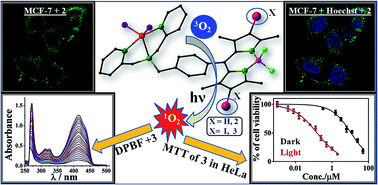Copper(II) complexes of N,N,N-donor dipicolylamine ligands, viz. [Cu(L1)Cl2] (1), [Cu(L2)Cl2] (2) and [Cu(L3)Cl2] (3) with L2 and L3 having BODIPY (borondipyrromethene) moieties were synthesized, characterized and their photocytotoxicity studied. Complex 1 was structurally characterized by X-ray crystallography. It has copper(II) in a distorted square-pyramidal geometry (τ = 0.11) with two chloride ligands in axial-equatorial cis-disposition. The one-electron paramagnetic and redox active complexes are non-electrolytic in DMF. They behave as 1 : 1 and 1 : 2 electrolytes in 1 : 1 and 1 : 9 (v/v) DMF–H2O. The BODIPY complexes 2 and 3 show respective visible bands at 501 nm and 535 nm in DMF. Complex 2 displays an emission band at 515 nm in DMF (λex = 465 nm) with a quantum yield (ΦF) value of 0.14. This complex, as a fluorogenic probe for cellular imaging, shows cytosolic localisation of the complex in HeLa and MCF-7 cancer cells. Complex 3 having a diiodo BODIPY unit in L3 is non-emissive but acts as an efficient photosensitizer showing a significant PDT effect with apoptotic cell death forming singlet oxygen as ROS (ϕΔ = 0.53) and giving respective IC50 values of 0.15 ± 0.02 and 0.17 ± 0.03 μM in HeLa and MCF-7 cancer cells in visible light of 400–700 nm, while being less toxic in the dark.

